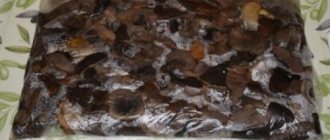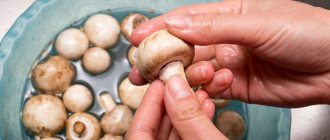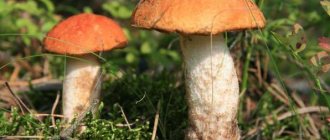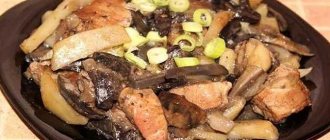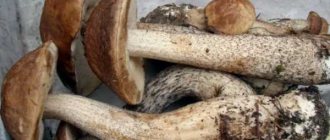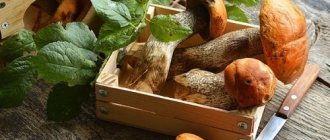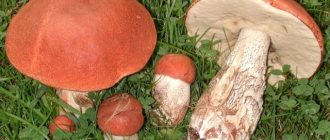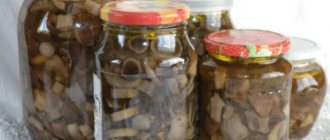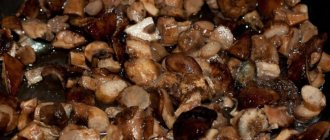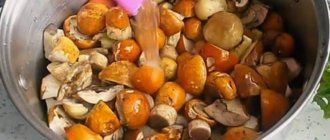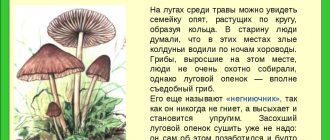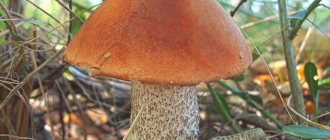Boletuses and boletuses are beautiful and aromatic mushrooms. They cannot be stored fresh for a long time, which is why they try to save them for the winter or prepare something. And there are a huge variety of recipes for treats made from such mushrooms: soups, pies, sauces, pastes, fried potatoes with mushrooms, stews and others. Let's look at how to cook boletus and boletus mushrooms.
Important: many people believe that if the mushrooms are fried and also go into the soup, then they do not need to be boiled, since this is an additional heat treatment that can worsen the taste of the product. But this is not so - mushrooms must be boiled, because during this process all toxins and harmful substances are released from them. How long to cook mushrooms depends on what dish they are used in, but heat treatment should last at least 35 minutes.
Since these 2 types of forest fruits are somewhat different, they should be cooked differently. Let's look at the process of cooking them separately.
What do aspen and boletus mushrooms look like?
Boletus and boletus are sponge mushrooms. Their stem has a cream color, with small inclusions (in boletus they are more pronounced). But the cap, as a rule, is painted in bright yellow-brown shades, and sometimes almost red in the boletus. The color of the cap is perhaps the only sign of difference. Mushrooms grow in young birch and aspen forests, usually along the edges.
Fungus growing under a birch tree
Having noticed a boletus in the forest, you need to make sure that it is exactly him. Many are not professional mushroom pickers, although they can make mistakes. It can be found in birch groves. He really loves these trees. The name of the specimen speaks for itself.
Boletus mushrooms have more than 40 varieties. Outwardly they are similar to each other. The young-looking cap is white. As it matures, it acquires a dark brown tint. The shape immediately resembles a hemisphere, then gradually becomes cushion-shaped. The surface is covered with mucus. The diameter of the caps can grow up to 18 centimeters.
The stem of the boletus is cylindrical. It extends 15 centimeters in height. It has dark gray scales. In a mature mushroom it becomes hard and contains fibers. And so, the species is characterized by white flesh, which darkens a little when cut. It's dense. It is better to collect young mushrooms, since in adults the pulp becomes watery and loose. The ripening time for boletus is 6 days. Then he starts to age. Worms appear in it.
Preparing mushrooms
The first stage is preparing the mushrooms. Let's start with the fact that for any type of preparation, mushrooms should be used that are not wormy and preferably fresh. Freshly picked boletus and boletus are ideal not only for cooking, but also for pickling and drying.
Before cooking boletus and aspen mushrooms, they need to be cleared of dry debris. If you are going to dry mushrooms, then under no circumstances should you wet them. It will be enough to wipe with a damp sponge. Boletus mushrooms are not very suitable for drying; it is best to use boletus mushrooms. Darkened areas should be cut off.
Features of the species
Fragrant and appetizing boletus and aspen mushrooms have always been an integral food product in Russia. Despite the fact that both types are similar to each other, they still have significant differences.
boletus
Walking through a birch grove, especially in places where the sun warms the ground well, you can often find a boletus mushroom - tall, slender, on a long leg and wearing a beautiful convex hat, which over time becomes like a pillow. Its diameter can reach 15 cm. In its appearance, the boletus mushroom resembles a porcini mushroom, but unlike it, the boletus leg is covered with small gray or black scales.
The color of the fruit varies depending on the place of growth and can be from light beige to black and brown. There are several types of boletus: Common, Swamp (or White), Black, Pinkish, Tundra, Hard, Gray and Multi-colored.
The most common boletus is the common boletus. It is recognized by its uniform color and stem, which thickens at the bottom. They love it not only for its taste. Boletus cleanses the body of toxins, has a positive effect on the nervous state, regulates blood sugar, helps with kidney problems, has a beneficial effect on the skin and is not high in calories (only 20 kcal per 100 g) and is rich in various microelements necessary for the body.
Boletus
In mixed forests and aspen groves you can find mushrooms with bright red caps and a stocky stalk covered with scales. These are boletuses. They received this name because of their color, which is very reminiscent of the autumn foliage of aspen.
But contrary to popular belief that these mushrooms grow only near aspen trees, they can be seen under oaks, lindens, poplars, willows and other trees. They also love to live in a humid environment among moss, blueberry bushes, grass and ferns.
There are several types of boletuses. The most famous are: Red, Painted Legs, White and Oak. Boletuses are very valuable for their healing properties. It is believed that they cleanse the blood, help reduce cholesterol, remove heavy metal salts, poisons and radionuclides, have an antitumor effect, help normalize the intestinal microflora, and increase immunity.
How to freeze mushrooms for the winter?
You can freeze both boletus and boletus mushrooms, just keep in mind that it is recommended to store frozen mushrooms for no more than six months. There are also several ways to freeze. Some people freeze already boiled or fried mushrooms, but it is still preferable to use fresh boletus and boletus mushrooms for these purposes. For freezing, it is best to select small young mushrooms, and leave large mature specimens for dinner. For ease of freezing, the caps are most often separated from the stems, but this is a matter of taste. It is advisable to defrost mushrooms in the refrigerator, and you need to use the entire bag at once; they cannot be stored further.
How is boletus useful?
The special value of boletus mushrooms is that they contain well-balanced protein , including leucine, tyrosine, arginine, and glutamine.
Boletyozovik has a sufficient supply of vitamins - B, C, D, PP and E.
Thanks to dietary fiber, boletus absorbs and then removes various toxins from the body.
Boletus is an excellent antioxidant.
Boletus mushrooms are effective for treating kidney pathologies, the nervous system, and regulating blood sugar. They are beneficial for the health of the skin and mucous membranes. Due to the large amount of phosphoric acid, which is involved in the construction of enzymes, boletus mushrooms are a valuable product for improving the functioning of the musculoskeletal system.
Preparing for cooking
If the specimens are large, then you need to clean the film from the mushroom stem and cap. Before marinating and cooking, mushrooms should be washed well. Aspen and boletus mushrooms intended for frying can also be washed, but it is best under running water, avoiding too much water getting on the spongy part of the mushroom (it absorbs water very quickly and in the future, when you start frying mushrooms, you will have to evaporate it for a long time). Do not be alarmed if the boletus turns bluish when cut - this happens as a result of oxidation. Simply cut off the darkened area. This once again suggests that boletus and boletus mushrooms need to be processed immediately - the sooner the better. The blue or blackening of sections on boletus also allows one to distinguish it from the porcini mushroom, with which it is sometimes confused.
How to cook?
Next, based on taste preferences, everyone chooses for themselves how to cook boletus and boletus mushrooms. To pickle mushrooms, make soup or store them for the winter, you need to know how to cook boletus. Prepare two pans of boiling water for cooking in advance. Place the mushrooms in the first pan of boiling water, then let the water boil again. After boiling, immediately, using a slotted spoon, transfer the mushrooms to a second pan of boiling salted water and cook until tender for about twenty minutes. Do not let the water boil too hot. The degree of readiness can be easily determined - the finished mushrooms sink to the bottom of the pan. To marinate, place the prepared boiled mushrooms in jars and fill with marinade. Spices and vinegar are added to taste. There should be an air “cushion” left in the jar, so there is no need to fill the mushrooms with marinade right up to the neck. Also, boiled boletus and boletus mushrooms can be used to make soups and sauces.
Fried boletus with potatoes
One of the ways to prepare boletus is by frying. Most often they are fried together with potatoes. And to serve mushrooms separately as a side dish, it is better to stew them. The recipe for how to cook boletus with potatoes is extremely simple. The washed mushrooms should be cut into thin slices. Heat vegetable oil or butter in a deep frying pan, then add mushrooms and fry over medium heat for 20-30 minutes. Keep in mind that boletus and boletus fry very much and lose weight. Mushrooms need to be stirred periodically. Cut the potatoes into cubes or cubes and add to the prepared mushrooms, then fry until the potatoes are ready. Just before the end of cooking, be sure to add finely chopped onions and herbs to taste.
Using mushrooms in your diet is simple, the main thing is to know how to cook. Boletus and boletus mushrooms are universal mushrooms. They can be boiled, stewed, dried, pickled, salted, fried, frozen. This is a very valuable source of vegetable protein and fiber.
When to collect
All of the above types of boletus can form fruiting bodies from late May to mid-November, until the first frost. Periods of stable fruiting: August - October. However, experienced mushroom pickers always predict the time of appearance of the first representatives of boletaceae, depending on many conditions: whether last year was a “mushroom year” (as they say, one year does not coincide), how dry the last summer was, and how frosty the last winter was. Again, it is known that periods of high mushroom yield in a certain pattern alternate with periods of complete absence of mushrooms.
Did you know? The people still maintain the belief that a too mushroom year foreshadows war. Perhaps this is just a coincidence, but in the fall of 2014, Ukrainian mushroom pickers returned from a “quiet hunt” with truly unprecedented harvests...
During the collection process, you should remember that boletus is a very “vulnerable” mushroom.
It will be interesting to know how to distinguish toadstool and poisonous mushrooms growing on trees from edible mushrooms and boletus mushrooms.
